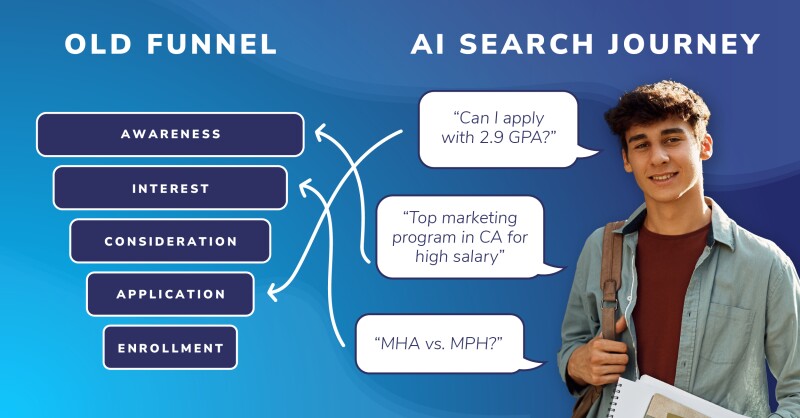For years, higher ed marketers have mapped their content strategies around a linear enrollment funnel: Awareness → Interest → Consideration → Application → Enrollment.
It made sense in a world where you controlled the messaging, and they moved predictably through discrete stages.
But that world is gone.
Today’s prospective student no longer follows a funnel. They express intent, and AI redirects their journey.
Funnel Thinking Doesn’t Match Student Behavior Anymore
AI-assisted tools like ChatGPT, TikTok search, Reddit, and Google’s AI Overviews have collapsed the traditional enrollment journey. Students can go from “casually curious” to “ready to apply” in a single sitting—without ever touching your carefully built nurture flow.
Where institutions once controlled the journey with curated information, students now drive it by asking nuanced questions and receiving personalized answers in real time. Instead of piecing together resources from multiple sources, they can get tailored, conversational guidance in one place—almost like having an admissions advisor on demand.
They’re asking questions like:
- “Is an MHA or MPH better for public health policy jobs?”
- “What’s the tuition at University of X?”
- “Can I apply to an online MBA with a 2.9 GPA?”
Those aren’t stage-based queries. They’re intent-based actions—and the ability to get fast, individualized responses is what collapses the funnel as we knew it.
Why This Matters in 2025
AI-enhanced search (e.g., Google’s Overviews, ChatGPT plugins) is already reshaping discovery behavior. Institutions are watching their tried and true digital marketing channels collapse, with the numbers showing:
- CPCs and cost-per-lead rise as AI reshuffles visibility and pushes organic content down the page.
- Lead volume decline, but conversion rates improve, as more intent-rich traffic reaches application pages.
- Organic traffic from non-brand search shrink, especially when AI tools bypass traditional SERPs.
Students aren’t “starting at the top of the funnel” anymore—they’re showing up halfway down, already informed by AI. And when they hit your website, they expect relevance.
The Strategic Shift: From Funnel Thinking to Intent Mapping
Here’s what this shift looks like in practice for enrollment marketers:
Intent-based content isn’t just about keywords—it’s about use case, urgency, and context.
How to Operationalize Intent-Based Content Development
For higher ed marketers navigating tight budgets, AI disruption, and yield pressure, this model offers a more resilient, ROI-focused approach. Here’s how to shift:
- Audit content by intent, not just topic.Map your key pages, ads, and content assets to intent types. Where are you missing transactional or commercial content? Where are you overproducing generic informational content?
- Use student questions to shape content.Pull queries from SGE, ChatGPT, Reddit, and TikTok to understand what real students are asking—and which intent type it signals. Also, combine these with actual questions from campus visits and admissions calls to understand what real students are asking—and which intent type it signals.
- Reoptimize high-intent pages first.Focus SEO and conversion work on pages aligned with Transactional and Commercial queries. These pages show the highest short-term impact on inquiry and application volume.
- Reframe internal reporting.Stop presenting content performance by funnel stage alone. Start showing ROI by intent cluster—which types of content drive starts, not just clicks.
If funnel thinking gave you too many assumptions and not enough evidence, intent mapping gives you the reverse: real behavior signals, clear optimization paths, and measurable results.
In an AI-disrupted, high-pressure environment, it’s not just more effective—it’s more defensible.
Because when you show that you're targeting intent, not just eyeballs, you’re no longer explaining marketing theory to your president—you’re explaining student behavior.
And that’s a conversation you can win.

